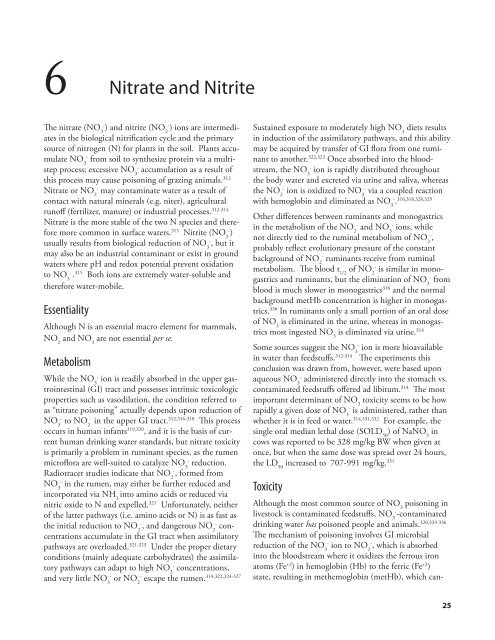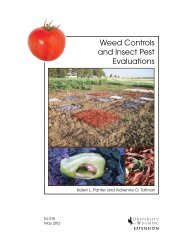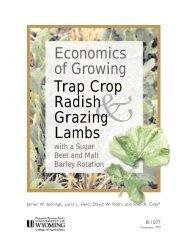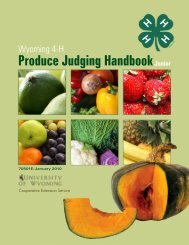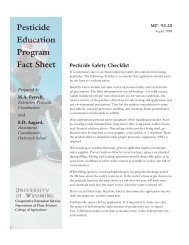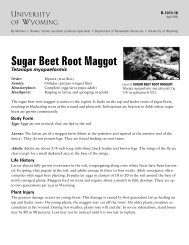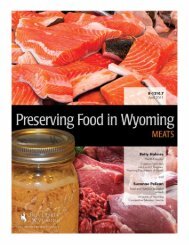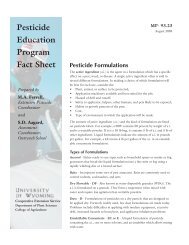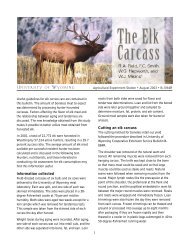Water Quality for Wyoming Livestock & Wildlife - Coming Soon!
Water Quality for Wyoming Livestock & Wildlife - Coming Soon!
Water Quality for Wyoming Livestock & Wildlife - Coming Soon!
You also want an ePaper? Increase the reach of your titles
YUMPU automatically turns print PDFs into web optimized ePapers that Google loves.
6 Nitrate and NitriteThe nitrate (NO 3-) and nitrite (NO 2-) ions are intermediatesin the biological nitrification cycle and the primarysource of nitrogen (N) <strong>for</strong> plants in the soil. Plants accumulateNO 3-from soil to synthesize protein via a multistepprocess; excessive NO 3-accumulation as a result ofthis process may cause poisoning of grazing animals. 312Nitrate or NO 2-may contaminate water as a result ofcontact with natural minerals (e.g. niter), agriculturalrunoff (fertilizer, manure) or industrial processes. 312-314Nitrate is the more stable of the two N species and there<strong>for</strong>emore common in surface waters. 315 Nitrite (NO 2-)usually results from biological reduction of NO 3-, but itmay also be an industrial contaminant or exist in groundwaters where pH and redox potential prevent oxidationto NO 3-. 315 Both ions are extremely water-soluble andthere<strong>for</strong>e water-mobile.EssentialityAlthough N is an essential macro element <strong>for</strong> mammals,NO 2and NO 3are not essential per se.MetabolismWhile the NO 3-ion is readily absorbed in the upper gastrointestinal(GI) tract and possesses intrinsic toxicologicproperties such as vasodilation, the condition referred toas “nitrate poisoning” actually depends upon reduction ofNO 3-to NO 2-in the upper GI tract. 312,316-318 This processoccurs in human infants 319,320 , and it is the basis of currenthuman drinking water standards, but nitrate toxicityis primarily a problem in ruminant species, as the rumenmicroflora are well-suited to catalyze NO 3-reduction.Radiotracer studies indicate that NO 2-, <strong>for</strong>med fromNO 3-in the rumen, may either be further reduced andincorporated via NH 3into amino acids or reduced vianitric oxide to N and expelled. 321 Un<strong>for</strong>tunately, neitherof the latter pathways (i.e. amino acids or N) is as fast asthe initial reduction to NO 2-, and dangerous NO 2-concentrationsaccumulate in the GI tract when assimilatorypathways are overloaded. 321-323 Under the proper dietaryconditions (mainly adequate carbohydrates) the assimilatorypathways can adapt to high NO 3-concentrations,and very little NO 3-or NO 2-escape the rumen. 314,322,324-327Sustained exposure to moderately high NO 3diets resultsin induction of the assimilatory pathways, and this abilitymay be acquired by transfer of GI flora from one ruminantto another. 322,323 Once absorbed into the bloodstream,the NO 3-ion is rapidly distributed throughoutthe body water and excreted via urine and saliva, whereasthe NO 2-ion is oxidized to NO 3-via a coupled reactionwith hemoglobin and eliminated as NO 3-. 316,318,328,329Other differences between ruminants and monogastricsin the metabolism of the NO 2-and NO 3-ions, whilenot directly tied to the ruminal metabolism of NO 3-,probably reflect evolutionary pressure of the constantbackground of NO 2-ruminants receive from ruminalmetabolism. The blood t 1/2of NO 2-is similar in monogastricsand ruminants, but the elimination of NO 3-fromblood is much slower in monogastrics 316 and the normalbackground metHb concentration is higher in monogastrics.330 In ruminants only a small portion of an oral doseof NO 3is eliminated in the urine, whereas in monogastricsmost ingested NO 3is eliminated via urine. 314Some sources suggest the NO 3-ion is more bioavailablein water than feedstuffs. 312-314 The experiments thisconclusion was drawn from, however, were based uponaqueous NO 3-administered directly into the stomach vs.contaminated feedstuffs offered ad libitum. 314 The mostimportant determinant of NO 3toxicity seems to be howrapidly a given dose of NO 3-is administered, rather thanwhether it is in feed or water. 314,331,332 For example, thesingle oral median lethal dose (SOLD 50) of NaNO 3incows was reported to be 328 mg/kg BW when given atonce, but when the same dose was spread over 24 hours,the LD 50increased to 707-991 mg/kg. 331ToxicityAlthough the most common source of NO 3poisoning inlivestock is contaminated feedstuffs, NO 3--contaminateddrinking water has poisoned people and animals. 320,333-336The mechanism of poisoning involves GI microbialreduction of the NO 3-ion to NO 2-, which is absorbedinto the bloodstream where it oxidizes the ferrous ironatoms (Fe +2 ) in hemoglobin (Hb) to the ferric (Fe +3 )state, resulting in methemoglobin (metHb), which can-25


